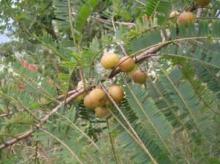Emblica officinalis (also known as Phyllanthus emblica, Indian gooseberry, or by its Hindi name amla) is a deciduous tree, the fruit of which is a rich dietary source of vitamin C as well as various minerals, amino acids, and phenolic compounds. Native to India, and found also in China, Indonesia, and the Malay Peninsula, amla has long been used in Ayurvedic medicine, and is highly regarded for its unique array of tannins (particularly emblicanin A and emblicanin B) and flavonoids, which exhibit antioxidant activity (Asian Pac. J. Cancer Prev. 2005;6:197-201).
In fact, the amla fruit is known to impart strong antioxidant activity and to protect human dermal fibroblasts against oxidative stress. Therefore, it is considered a useful adjuvant in natural skin care (J. Ethnopharmacol. 2008;119[1]:53-7). This column will focus on the recent research pertaining to modern medical usage and the potential dermatologic applications of this plant traditionally used in Indian medicine.
Antioxidant Properties
In 2002, a standardized extract of E. officinalis (trade name, Emblica) was found to exert a long-lasting and broad-spectrum antioxidant activity, appropriate for use in antiaging, sunscreen, and general purpose skin formulations given its demonstrated capacity to protect the skin from damage engendered by free radicals, nonradicals, and transition metal-induced oxidative stress (Skin Pharmacol. Appl. Skin Physiol. 2002;15:374-80). In addition, Emblica appears to be an ideal combination of the characteristics necessary for an effective skin-lightening ingredient. Specifically, it inhibits tyrosinase and/or tyrosinase-related proteins (TRP-1 and 2) and peroxidase/H2O2 at various points in the melanogenesis pathway (Skin Pharmacol. Appl. Skin Physiol. 2002;15:374-80), and acts as a broad-spectrum cascading antioxidant. (Antioxidants comprise one group of suitable hypopigmenting agents.) Emblica, which is photochemically and hydrolytically stable, therefore suitable for inclusion in skin care formulations, is thought to be comparably efficacious to hydroquinone and kojic acid as a skin-lightening compound, but without posing the same risks or likelihood of eliciting adverse effects.
Also in 2002, Morganti et al. assessed the in vitro and in vivo activity of various topical antioxidants and nutritional supplements in a randomized double-blind placebo-controlled study conducted over 8 weeks on 30 female volunteers (aged 48-59 years), with moderate dry skin and photodamage. All subjects twice daily applied a nanocolloidal gel and/or daily took two capsules of an oral diet supplement. The test formulations were antioxidant-enriched, containing ascorbic acid, tocopherol, alpha-lipoic acid, melatonin, and emblica. Oral and topical administration of the antioxidant compounds resulted in significant reduction in oxidative stress (ROS) and lipid peroxidation. Free radicals recovered in blood serum and on skin, in vivo, and ROS induced by in vitro irradiation of leucocytes with UVB, were also decreased in antioxidant-treated patients. The investigators concluded that all of the compounds, including emblica, showed therapeutic potential, in topical or systemic form, as photoprotectants and agents intended to lower the oxidative stress of photoaging-affected individuals (Int. J. Cosmet. Sci. 2002;24:331-9).
Oxidative Stress Reduction Properties
Yokozawa et al. studied the effects of amla on the lipid metabolism and protein expression in age-related oxidative stress. They administered a dose of SunAmla or ethyl acetate extract of amla, a polyphenol-rich fraction, to young rats aged 2 months and aged rats (10 months) and found that the lipid levels were significantly higher in aged control rats, but significantly reduced as a result of amla administration. Several additional metrics in the study led the team to conclude that amla, by diminishing oxidative stress, may prevent age-related hyperlipidemia (Br. J. Nutr. 2007;97:1187-95). Recently, Sharma et al. investigated in adult Swiss albino mice the protective role of the fruits of E. officinalis against arsenic-induced hepatopathy. Significant increases in serum transaminases and lipid peroxidation content in the liver were noted in the arsenic-treated group, along with significant decreases in hepatic superoxide dismutase, catalase, glutathione-S-transferase and serum alkaline phosphatase activity. Pre- and post-treatment with amla reversed these effects. In addition, liver histopathology revealed that amla diminished karyolysis, karyorrhexis, necrosis, and cytoplasmic vacuolization caused by the arsenic. The authors concluded that pre- and postsupplementation with E. officinalis fruit extract significantly reduces oxidative stress in the liver generated by arsenic (Chem. Biol. Interact. 2009;180:20-30).
Cutaneous Properties
Recent investigations with emblica also have dermatologic implications or suggestions of potential cutaneous benefits. In 2005, Sancheti et al. performed a two-stage skin carcinogenesis study in Swiss albino mice to ascertain the chemopreventive action of E. officinalis fruit extract. A single application of 7, 12-dimethyabenz(a)anthracene (DMBA) was used to induce skin cancer, followed 2 weeks later by thrice weekly applications of croton oil (through the end of the 16-week experiment) to promote tumors. A statistically significant difference in tumor incidence, yield, and burden as well as cumulative number of papillomas favored the mice treated with E. officinalis as opposed to the control group. The investigators concluded that E. officinalis fruit extract exhibited chemopreventive potential against DMBA-induced skin cancer in Swiss albino mice (Asian Pac. J. Cancer Prev. 2005:197-201).


